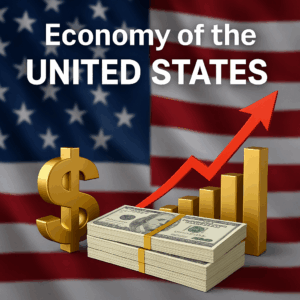
The American Economy: A Brief History of 2025
The U.S. economy is frequently considered the most powerful economy in the world. The U.S. is a major source of invention, capital, and trade and its own economy influences global economic patterns also. This article presents a general description of the US economy in 2025, discussing its major sectors, past trends, challenges, and future prospects.

📊 The U.S. Economy: A Look at the Numbers
The United States has a mixed market economy, in which all organizations are based on social cooperation between individuals, co-operation being the voluntary coordination of labor and exchange for mutual benefit of the cooperants. As of 2025, the U.S. economy is the world’s biggest at $28 trillion.
Key Characteristics:
- GDP (2025): Over $28 trillion
- Unemployment Rate: About 4.0%
- Rate of Inflation: Levelled off at about 2.5%
- Currency: U.S. Dollar (USD)
- Economic structure/form: Capitalist, with striking private sector predominance.
🏭 Key Economic Sectors
- Services Sector (80% of GDP)
The United States economy is driven by the services sector. This spans finance, health care, education, technology, entertainment and professional services. Large companies like Apple, Microsoft, Google and Amazon make huge sums of money from technology and services. - Manufacturing and Industry
While traditional manufacturing has declined in the U.S. over the years, the country is still a major player in high-tech manufacturing and aerospace, defense and pharmaceuticals. Companies such as Boeing, Tesla and Pfizer are major donors. - Agriculture
The U.S. continues to be a leading exporter of agricultural goods, including soybeans, corn, wheat and meat. This essential industry, in a world of broadband and handouts, is kept alive despite contributing so little to GDP. - Energy Sector
(Burned oil and gas fuels energy production and vehicle use.) The U.S. is already a top producer of oil and natural gas, and has quickly grown off of renewable energy sources like solar, wind, and biofuels.
💼 Work and Labor The Worker’s Friend
While some colleagues avoid him, Rudy Maldonald, a fixture at a midtown office cleaning a building home to several investment firms, knows everyone’s name, what they do and how many children they have.
The U.S. labor market in 2025 is characterized by:
- Low unemployment: The result of robust demand in tech, healthcare and service industries.
- The rise of remote: More companies are moving to hybrid or all-remote operation.
- The growth of the gig economy: Uber, DoorDash and Fiverr are among the platforms making a living in the gig economy possible — if not so stable.
- Skills gap: Even with the low unemployment, many employers have difficulty finding workers with very specific technical skills.
- Post-Pandemic Recovery
The U.S. economy has bounced back completely from the pandemic-induced shocks. Consumer spending snapped back robustly after being restrained by pandemic restrictions and high unemployment, helped by government stimulus and low-interest rates. - Inflation Control
Following the high inflation of 2022–23, the Federal Reserve proved effective at stabilizing inflation with only mild repercussions—penalizing growth but not leading to a recession. - Technological Innovation
The U.S. is ahead in artificial intelligence, blockchain, electric cars, biomedicine, and space exploration. This in turn contributes to job creation and higher GDP. - Sustainable Economy
There’s a big shove toward green power and sustainability. There are federal and state incentives to encourage businesses to be more green.
📈 Economic Trends in 2025
Reserve A measure of manufacturing output in New York and a reading of a regional factory index at the Philadelphia Federal Reserve could offer new evidence of the pace of recovery in American manufacturing.
Central Banks[ xix ] play a critical role in controlling the economy.
Main Tools:
- Adjusting interest rates
- Quantitative easing/not Quantitative easing not.readdir.readdir as ever, that does require bookmarking and regular management to work effectively, but the same could be said for an RSS feed.
- Monitoring price changes and employment costs
- In 2025, it must balance interest rates to keep the economy from boiling over while also cooling it off.
💰 Monetary Policy and the Federal
It’s still a tough market for home buyers in U.S.
- Interest Rates: Toned down from 2023 peak levels.
- Home prices: Have leveled off after surging in the pandemic.
- Challenges: Limited affordability in cities like New York, Los Angeles and San Francisco.
🏡 Housing Market
⚠️ Major American Economy Struggles Editor’s Note
To borrow from the title of a recent Wall Street Journal profile, the French economist Thomas Piketty is the “scourge of the one percent.” In many quarters, including here on the Opinion side of The Times, he has been celebrated as a prophet whose time has come.
There Are Complicated Headwinds Junker Drill’s stock is red-hot, running off the energy from Trumponomics. It’s bottom line, however, is entirely driven by the U.S. economy. For now, unlike the other three major global regions, the U.S does not appear to be stuck in a smothering bearish trend that threatens to knock shares decisively lower for much of the last 18 months. If easy money ever becomes greenlit again, as central bank’s and especially the Federal Reserve may be forced to do, this unusually large but short lived bear retreat has the potential to ignite equities into another furious rally. Despite that strength, there are formidable challenges:
- National Debt: Above $34 trillion, worrying the long-term fiscal sustainability of the nation.
- Wealth Inequality: The divide between the rich and poor is widening.
- Tough Health/Fitness Costs Upward trends in health/fitness costs are a burden to individuals and employers.
- World Competition: Dwindling due to growing competition from the developing world, in particular China and India.
- And what about the Climate Change: Various natural disasters and climate risks weigh on the agriculture, infrastructure and insurance sectors.
Positive Drivers:
- Further development and progress in technology, renewable energy and healthcare.
- We have strong consumers with a lot of disposable income.
THE ENTREPRENEURSHIP AND INNOVATION CULTURE IS STRONG.
Potential Risks:
- Military conflicts (eg, with China, Russia, Middle East).
- Threats of cybersecurity to financial and infrastructure systems.
- Shortfalls of workers in critical fields such as health care and engineering.
Forecast (2025-2030):
- You will experience average annual GDP growth rates of 2-3%.
- RBA inflation to be kept within the 2-2.5% target band.
- Solid job growth, particularly in digital and green.
🔮 The Next American Economy What should you believe is going to happen in the U.S. economy?
The U.S. economy is still a juggernaut on the world stage, fueled by innovation, robust consumer spending and a diverse mix of industries. Debt, disparity and global challenges endure but the U.S. adapts with technology, legislation and entrepreneurism. With 2025 under way, the U.S.’ economic strength will set it up for the future to be a place of growth and global leadership.
⭐ Conclusion
There’s no question that the U.S. is a giant in the world of global trade.
Key Trade Partners:
- China
- Canada
- Mexico
- European Union
- Japan
Top Exports:
- Aircraft
- Machinery
- Vehicles
- Pharmaceuticals
- Agricultural products
Trade Challenges:
- Perpetual technology and intellectual property tensions with China.
- Supply chain disruptions, while getting better, are still affecting some industries.
- Tweaking of free-trade agreements such as USMCA (United States-Mexico-Canada Agreement) and talks with European and Asian countries.
- Post-Pandemic Recovery
The U.S. economy has bounced back completely from the pandemic-induced shocks. Consumer spending snapped back robustly after being restrained by pandemic restrictions and high unemployment, helped by government stimulus and low-interest rates. - Inflation Control
Following the high inflation of 2022–23, the Federal Reserve proved effective at stabilizing inflation with only mild repercussions—penalizing growth but not leading to a recession. - Technological Innovation
The U.S. is ahead in artificial intelligence, blockchain, electric cars, biomedicine, and space exploration. This in turn contributes to job creation and higher GDP. - Sustainable Economy
There’s a big shove toward green power and sustainability. There are federal and state incentives to encourage businesses to be more green.
📈 Economic Trends in 2025
🌎 International Trade and Relations
Our Post


Beyond Budgeting: Master Your Money with the Power of Conscious Spending

